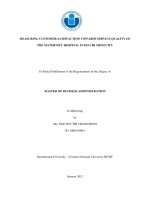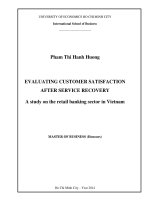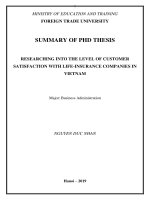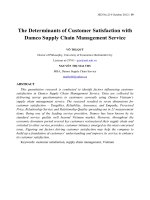Over the last two decades, the debate over customer satisfaction and service quality have remained among tourism and hospitality research topics.
Bạn đang xem bản rút gọn của tài liệu. Xem và tải ngay bản đầy đủ của tài liệu tại đây (105.65 KB, 10 trang )
ABSTRACT
Over the last two decades, the debate over customer satisfaction and service quality
have remained among tourism and hospitality research topics. Therefore, the current
study discusses service leadership styles from relevant service quality theory and
evaluates cross-culture management applications. Some recommendations for
human resource and marketing policies to improve the quality of hospitality
services are also proposed in the last section.
TABLE OF CONTENT
i
ABSTRACT..............................................................................................................i
TABLE OF CONTENTS........................................................................................ii
1. INTRODUCTION...........................................................................................1
2. Relevant theories relevant to service quality in the contemporary
hospitality industry.............................................................................................2
3. Service leadership............................................................................................2
3.1. Democracy leadership............................................................................2
3.2 Transformational leadership...................................................................2
3.3 Servant leadership...................................................................................3
4. Organisational culture....................................................................................3
5. Cross-culture Management............................................................................3
6. Recommendation.............................................................................................5
7. Conclusion........................................................................................................6
8. References........................................................................................................7
ii
1. INTRODUCTION
Customer service and satisfaction have emerged as critical topics in tourism and
hospitality research, attracting considerable attention from academics and
researchers. There have been numerous publications since the initial models of
service quality were published in the mid-1980s. In the long run, service quality is
critical to a company's profitability because it leads to repeat business and customer
loyalty (Rhoades, 2006). The approaches to investigating leadership principles and
service management, on the other hand, did not dominate research on service
quality and customer satisfaction in the tourism and hospitality industries. As a
result, these elements continue to provide a significant competitive advantage to
tourism and hospitality businesses. This study will look at leadership trends,
identify flaws, and make recommendations. The following section contains reviews
of the literature on organisational culture and the application of cross-culture
management in the hospitality industry. The study also investigates critical issues
affecting hospitality operations and solutions to these issues before concluding this
paper.
1
2. Relevant theories to service quality in the contemporary hospitality
industry
In 1988, Zeithaml defined service quality as "a customer assessment based on the
overall excellence of services." Although researchers generally agree on the
importance of service quality in customer satisfaction and firm performance, no
model for measuring service quality has been developed. Service quality has
multiple dimensions that vary depending on the service industry (Brady & Cronin,
2001). Nonetheless, service quality measurement allows managers to identify
customer service problems to improve efficiency and quality to satisfy customers
and fulfil their desires.
Since the early 1980s, when Gronroos introduced the Nordic model, the first
model for measuring service quality, service quality has been extensively
researched. He believes that technical qualities, as an outcome of service
performance, should be distinguished from functional attributes, which are a
subjective perception of the service provided. SERVQUAL, the most well-known
and widely used model in service quality, was introduced in 1985 by Parasuraman,
Zeithaml, and Berry. They first proposed ten dimensions for their model, but in
1988, they reduced the dimensions to five. This model measured the differences
between customer expectations and perceptions of the service along five suggested
dimensions.
The tourism industry is highly fragmented, with numerous sectors and subsectors catering to guests' needs. Visitors interact with various providers, and the
interaction process and service delivery reflect essential aspects of the tourism
consumption experience, such as value, quality, and satisfaction. In a nutshell,
hospitality service quality is determined by comparing the quality expected to the
quality of service received by the client (Laws, 2001). Hotel service quality is
defined as the level of customer satisfaction by service consumers.
From the manufacturer's perspective, service quality is the guarantee of
providing the service in accordance with the scenario using the professional skills of
the supply staff and management team (Raval, 2012). From the customer's
perspective, service quality is the level of customer satisfaction during service
consumption, as well as the overall service of the organization that brings a chain of
benefits and fully fulfils the expected needs of customers proportionate with the
costs that customers pay.
3. Service leadership
Eisenbeiss (2009) stated three main leadership principles in the light industry:
democracy, transformational and servant leadership. Each principle has outstanding
features, but there are also specific limitations when applied to the hospitality
industry.
3.1. Democracy leadership
While democracy is considered one of the most effective governance trends, this
method is not wholly perfect. Limitations of the democratic leadership style in the
hospitality industry include delayed decision-making, risk of poor quality solutions
2
and dissent. Where the team members' roles are not clearly defined will cause
delays in making decisions. At that time, gratis management can lead to ineffective
internal communication, affecting the ability to achieve the desired goals. Also,
disagreement is inevitable, leading to decreased employee morale and satisfaction.
3.2 Transformational leadership
Transformational leaders frequently prioritize individual needs, which leads to
employee burnout (Niemiec, 2020). Transformational leaders value diversity
because more perspectives and experiences lead to more significant innovation.
Transformational leaders motivate employees to seek opportunities to expand their
hospitality expertise to foster diversity. Individual needs are frequently the focus of
the leader rather than the needs of the group as a whole, implying that one team
member receives more attention than others in the field. This results in a lack of
trust among team members, which eventually affects work productivity. However,
if a high level of productivity is required for extended periods of time, it can lead to
employee exhaustion.
3.3 Servant leadership
According to Lacroix (2017), servant leaders can over-abdicate power and fade into
the woodwork in their attempt to "lead from behind," inadvertently making their
impact invisible to the organisation. They may seek refuge in the comfort of serving
their employees, preferring not to engage higher up the chain and thus failing to
establish a strong presence with their leaders. All hospitality organisations value
servant leaders, but they also expect them to be highly competent leaders in their
field, with authority, control and the power to influence in all directions (Cho,
2015). Furthermore, classic servant leaders frequently clash with bosses who do not
share the same leadership philosophies. Priorities, for example, can quickly clash
when the servant leader seeks to protect the people first and the leader seeks to
protect profit first. This disagreement can erode the servant leader's trust in the eyes
of their boss, making it harder for them to obtain the resources and support they
require to serve their constituents best.
4. Organisational culture
A manager may face common organisational problems when providing
services to foreigners, are poor communication, ambiguity, and inconsistency.
These are directly related to a hostile and unpleasant workplace. These will make
foreign workers less loyal, increasing harassment and employee turnover. When
working in an international environment, businesses of all sizes face the issue of
poor communication (Kramer, 2016). They may feel awkward when
communicating their company's goals, ideas, and suggestions. Uncertainty is
another organisational culture issue that managers may face. Employees may be
unclear about what their manager expects of them and may believe that the
company's policies contradict actual practices.
One of the organisational cultural issues is inconsistency. Employees may
believe that hotel policies are not applied fairly at times. Employees, for example,
may expect to be punished if they cannot complete their work, but they also suspect
that managers will not be punished for the same issues. They will not accept that
3
some departments benefit more than others within the same organisation. Other
organisational culture issues include priority differences. Employees may believe
that a hotel is overly concerned with making money, that they are being denied
rights such as breaks and overtime, or that they are being forced to work longer
hours. Employee performance can suffer from these attitudes, such as widespread
anger. Another organisational cultural issue is poor leadership. Employees may not
respect or obey the manager if they believe the manager's leadership is inconsistent,
weak, or disreputable. This can exacerbate organisational culture issues (Gavaghan,
2000).
5. Cross-culture Management
One of the most difficult challenges for employees and managers of
hospitality organisations that are increasingly conducting international business is
interacting and working effectively with people from different cultural
backgrounds. Cross-cultural leadership refers to how leaders operate in the new
global marketplace. A service organisation requires leaders who can quickly adapt
to different business environments and easily interact with partners and employees
from other cultures. A successful manager in their native country may not be as
successful on the international stage. Cross-cultural leadership is explained from
two perspectives (Krause, 2006). From an organizational standpoint, cross-cultural
leadership refers to the individual in charge of establishing a business organization.
Employees in this organization come from various nationalities, cultures, and
values backgrounds. From this vantage point, cross-cultural leadership can be seen
in multinational corporations. The second point of view concerns cultural exchange
and change; cultural leadership includes adapting to a new wave of globalization.
Cross-cultural leadership is a distinct phenomenon that evaluates a leader's ability to
adapt and lead in culturally diverse environments.
Because of the dynamic environment, service orientation, and labourintensive nature of the hospitality industry, leadership skills are essential. Indeed, in
the customer service industry, where leadership style focuses on leaders' behaviour
rather than identifying leaders' characteristics, leadership style significantly
influences employees' behaviour. Language barriers and cultural differences can
cause problems when people from different cultural backgrounds fail to
comprehend each other. As a result, knowing a foreign language and understanding
cultural differences between countries is essential. Cultural understanding and
intercultural communication are now critical in interactions with hotel guests and
staff due to the international nature of the hospitality industry. There are several
explanations why hotel professionals should be aware of and manage these
interactions today. The significance of effective communication is widely
recognized today. Its importance in the hospitality industry cannot be overstated, as
better communication has been recognized as the key to improved quality,
productivity, and profitability. "One of the most difficult challenges a manager
faces is dealing with people," and communication is often one of the most
demanding environments to master. Miscommunication can have a significant
impact on business effectiveness, including a loss of reputation and credibility,
4
which can lead to financial problems and other issues. Hospitality managers spend
80% of their time communicating activities to guests, peers, bosses, and, most
frequently, subordinates, according to Singh and Banerjee (2018).
6. Recommendation
According to Moreo (2017), the two most important issues affecting
hospitality operations are human resources and marketing policy. Human creative
labour is a decisive factor in cross-culture business performance. The hotel needs
adequate investment to develop the retraining scale and train a team of intellectuals
and high-quality workers. In order to improve the existing shortcomings, the hotel
needs to develop a specific program and plan. Hotels can improve their staff's
foreign language skills and increase the bonus fund for employees. These solutions
encourage employees to find new customers and take advantage of their
relationships to introduce the hotel's services.
Self-sufficient travel has become a popular trend when customers are
increasingly active in finding information and booking rooms through online
platforms instead of using services at travel agencies (Seeman et al., 2019). So
tourist accommodation units, especially hotels, must know how to seize
opportunities and promote overall Online Marketing strategies to reach many target
customers. First, Websites are considered "faces" of the hotel on the Internet, which
customers will regularly visit and dig for information before deciding whether to
book. So investing in professional website design is always the ultimate marketing
solution for travel and hotel companies because customers often use travel
applications to book air tickets and hotel rooms. Second, linking with booking
applications allows hotels and travel businesses to display their services with all
images and information about prices, facilities and customer reviews. Along with
that, with the advantage of the number of users and the ability to reach and interact
well with customers, optimising social networks is also a highly effective online
marketing solution.
5
7. Conclusion
It is always critical to understand what type of leadership is best for business
success, but it is also necessary to select the management theory that will foster the
best relationship with employees. This study has raised several theories related to
service quality, thereby making objective comments on some hospitality principles
and the cross-culture management approach. In the end, this study discusses why
human resources and marketing policy are critical to a hotel's success and offers
some recommendations relevant to the post-Covid economic situation.
<1910 words>
6
8. References
Brady, M. K., and Cronin, J. J. (2001) Customer Orientation: Effects on
Customer Service Perceptions and Outcome Behaviors. Journal of Service
Research, 3(2), pp.241-251
Cho, E. (2015) Primary Identity of Missional Leaders: Servant Leader or
Leading Servant?. ACTS Theological Journal. 25, pp.95-122
Eisenbeiss, S. (2009) Transformational leadership and team innovation:
Integrating team climate principles. Strategic Direction. 25(6)
Gavaghan, H. (2000) Companies of all sizes are prospecting for proteins.
Nature. 404(6778), pp.684-685
Gronroos, C. (1982) Strategic Management and marketing in the service
sector (1st ed.):Helsingfors: Swedish school of Economics and Business
Administration.
Kramer, E. (2016) The Working Poor: Two Perspectives on Reality-A
Communication to the Editor Inviting a Discussion. Poverty & Public Policy.
8(3), pp.263-274
Krause, I. (2006) Hidden Points of View in Cross-cultural Psychotherapy
and Ethnography. Transcultural Psychiatry. 43(2), pp.181-203
Lacroix, M. and Pircher Verdorfer, A. (2017) Can Servant Leaders Fuel the
Leadership Fire? The Relationship between Servant Leadership and Followers’
Leadership Avoidance. Administrative Sciences. 7(1), pp.6
Laws, E. (2001) Service Problems, Service Crises and Service Disasters.
Journal of Quality Assurance in Hospitality & Tourism. 2(1-2), pp.119-129
Moreo, A., Green, A. and O'Halloran, R. (2017) What certifications are
important in the hospitality industry?. Journal of Human Resources in Hospitality
& Tourism. 17(1), pp.121-135
Niemiec, R. (2020) Transformational Leadership and Employee
Psychological Needs. International Journal of Science Review. 2(3), pp.20-27
Parasuraman, A. Zeithaml, V. A. and Berry, L. L. (1985) A Conceptual
Model of Service Quality and Its Implications for Future Research. Journal of
Marketing, 49(4), pp.10.
Raval, T. (2012) A Perspective on Service Quality and Closing Service
Quality Gaps. Paripex - Indian Journal Of Research. 3(8), pp.83-85
Rhoades, D. (2006) Growth, customer service and profitability Southwest
style. Managing Service Quality: An International Journal. 16(5), pp.538-547
Seeman, N., Goldfarb, D., Kuzan, E. and Seeman, M. (2019) Feasibility of
Obtaining Sufficient Numbers of Responses to Questions About Travel Intentions,
Thereby Facilitating Effective Health Messaging. International Journal of Travel
Medicine and Global Health. 7(2), pp.48-52
7
Singh, R. and Banerjee, N. (2018) Exploring the Influence of Celebrity
Credibility on Brand Attitude, Advertisement Attitude and Purchase Intention.
Global Business Review. 19(6), pp.1622-1639
8









